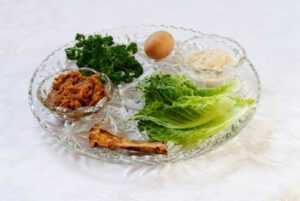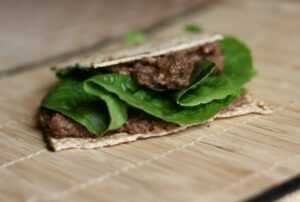
Well, Pesach is here, a holiday that is not generally considered a culinary event. Most people think of it as a holiday of lotsa-matzah and meat, and depending on your tradition, rice or potatoes. But if we take a look at the Seder symbols and the little appetizer ceremonies that precede the great meal, one may notice that lots of vegetables and some fruit take an honored role in the celebration. This week’s Newsletter turns the spotlight onto them.
The first to tickle the taste buds is the Karpas, which is basically any vegetable. Customs vary among using celery, parsley, radish, potato or onion. All these vegetables are now in season (along with many others), and therefore they’re each a great nibble-nosh possibility. The vegetable is dipped in salt water to arouse interest and curiosity. Eating a vegetable at the beginning of the evening is an appetizer that calms the hungry belly and allows for some further conversation regarding the present Haggadah text, and more that’s yet to come. It is also a mark of liberty and abundance, as appetizers are served when a bounty of food is available and there’s time and serenity to sit around and converse over dinner.
The next “shmear” is the Maror, and it includes the rest of the Seder plate vegetables – maror, horseradish and haroset. Maror is usually lettuce, which in this cultivated day and age is no longer bitter, at times even sweet, but the wild lettuce – particularly the “prickly lettuce” variety – is certainly pungent and explains its choice as a symbol of bitterness. Other Maror options were chicory, sea-holly (probably a purple thistle) and the chervil herb, as well as horseradish. Today we usually are kind to ourselves and eat lettuce, which from the description of the others definitely sounds like the best option. There are those who add spicy horseradish to the lettuce, perhaps aiming for the bitterness or because pungency is one of the stronger, more severe flavors. As a fan of the spicy, adding horseradish is a treat. I love how the sweet leaves meet the bitter root and the nose joins the party when the powerful whiff of horseradish hits it.
At the beginning, the Maror is eaten alone, but in the next round, another flavor is added to the piquant bitterness – sweet Haroset, made of fruit and nuts. Basically an excellent natural energy bar. Some make it more liquid, resembling date honey, and other times it’s a pesto-like spread. Then there are those who make it the texture of a finely-chopped salad. This season we have not yet encountered fresh fruit, so use dry fruit: figs, dates, walnuts and almonds. There are those who add apples and other natural sweeteners. Some years ago, when my daughter learned about the Seder customs at school, she wondered why we dip Maror in Haroset. As we explored the topic, we learned that some explain this is meant to lessen the bitterness of Maror. Others tie the bitterness of the slavery in Egypt to the Haroset, symbolizing the mortar used to adhere the bricks to each other, as the Israelites slaved away building the mammoth Egyptian monuments. My daughter came up with an idea I liked. She thought that they are eaten together so we can taste the entire gamut of the story at once, the bitter with the sweet, the anxiety and happy end, the distress and happiness. Another nice explanation we found belongs to Rabbi Avraham Eliyahu Ki Tov who ascertained that the Seder is comprised of a combination of enslavement and salvation. The combination of maror and haroset is one of bitter and sweet, teaching us that they both depend on us, on the way we view matters. One can see things like the Israelites in the desert – the maror (hardship) which lies within the haroset, or the world can be viewed optimistically seeing the haroset (sweetness) with the maror (hardship). This last explanation is all the more relevant this year. Our country is undergoing major whirlwinds, a complicated era of feuds, fear and uncertainty. I hope and wish we will be able to see all the good we have here, the love and compassion, care and determination, even within the existing chaos.The Seder is one busy evening, with a bevy of flavors sharing one table: salty, sweet, bitter and spicy. Different colors, multi-textures, varied desires… a colorful disarray. Sort of like a Chubeza box….
Wishing you a Chag Sameach! Enjoy the variety of flavors, enjoy the Seder and the disarray, the confused spring weather and the blessed renewal. From all of us at Chubeza, Happy Pesach and a peaceful spring. Looking forward to welcoming you all to the Open Day! _______________________________ WHAT’S IN THIS WEEK’S HOLIDAY BOXES? Monday + Tuesday: Lettuce, cabbage, kohlrabi, beets, carrots, fava beans/garden peas or snow peas, coriander/parsley, Swiss chard/kale, tomatoes, cucumbers, leeks/green garlic/onions. Large box, in addition: Zucchini/potatoes, bunch of fennel/turnips, celeriac/celery stalk/parsley root. FRUIT BOXES: Oranges/clementinas, red apples, avocados, bananas, pomelit/pomela..And there’s more! You can add to your basket a wide, delectable range of additional products from fine small producers: flour, sprouts & mushrooms, honey, dates, olives, almonds & pecan, garbanzo beans, quinoa, crackers, raw probiotic foods, olive oil, sourdough breads, gluten free breads, granola, natural juices, cider and jams, apple vinegar, dates silan, tachini, halva, almond & nuts butters, za’atar, herbal tea infusions and goat dairy too! You can learn more about each producer on the Chubeza website. On our order system there’s a detailed listing of the products and their cost, you can make an order online now!


